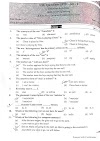Kathmandu: The Essential Travel & City Guide
Quick overview: Kathmandu, Nepal’s capital, sits at approximately 1,324 m (4,344 ft) in the Kathmandu Valley. A compact city by area but dense in history and culture, it’s the main gateway for visitors to Nepal and a hub for festivals, temples and lively marketplaces.
Quick facts!
- Country: Nepal
- Elevation: ~1,324 m (4,344 ft)
- Population (approx): 1.6–1.7 million (metro estimates vary)
- UNESCO monument groups in valley: 7 (Durbar Squares, stupas, temples)
- Airport: Tribhuvan International Airport (KTM)
Why visit Kathmandu?
~Kathmandu offers rich cultural immersion within a small area: medieval palaces, living temples with rituals happening daily, Tibetan Buddhist centres, handicraft markets and restaurants serving Nepali and Himalayan cuisine. For short trips (1–3 days) it’s one of the world’s most concentrated heritage experiences.
Top attractions (what you must not miss..)
- ~Kathmandu Durbar Square (Hanuman Dhoka) --> palace complex, museums and historic temples; ideal early morning or late afternoon to avoid crowds.
- Swayambhunath (Monkey Temple) --> panoramic views and a mixed Hindu–Buddhist site with prayer wheels and monkeys on the hilltop.
- Boudhanath Stupa --> one of South Asia’s largest stupas and the centre of Tibetan Buddhist life in Kathmandu.
- Pashupatinath Temple --> an active Hindu cremation and pilgrimage site on the Bagmati River (observe local rules; some areas are restricted for non-Hindus).
- Bhaktapur Durbar Square --> technically a separate town in the valley but a must-visit for pottery squares, wood-carved architecture and less touristy streets.
- Nagarkot viewpoint --> for mountain sunrises with views of the Himalaya (short drive from Kathmandu).
Neighborhoods & where to stay?
Thamel: Tourist hub --> lively, many guesthouses, restaurants and travel shops. Best for first-time visitors.
Durbar Marg / Lazimpat: Quieter upscale hotels, embassy area and better access to international dining.
Boudha (Bodhnath): Near Boudhanath stupa --> calmer, popular with those seeking a Buddhist atmosphere.
Patan/Lalitpur: South of Kathmandu —-> rich in art and quieter streets; recommended if you want a local feel.
Food & where to eat?
Must-try dishes: dal bhat (lentils, rice, curries), momo (dumplings), Newari specialities (chatamari, bara). For good local food, try small family-run restaurants in Thamel and Patan; for upscale Nepali fusion, check Lazimpat and Jhamsikhel.
*Sample itineraries*
1-day (packed)
Early: Swayambhunath (for sunrise and clear light) → Mid-morning: Durbar Square & local museums → Lunch in Thamel → Afternoon: Boudhanath → Sunset visit to Pashupatinath (view from outside the main cremation platforms).
2-day (relaxed)
Day 1: Thamel, Durbar Square, Patan Durbar Square in late afternoon. Day 2: Swayambhu and Boudha; evening at a rooftop cafe.
3–4 day (culture + short escapes)
Add a day-trip to Bhaktapur and a sunrise stay in Nagarkot or an easy hike to Shivapuri National Park for nature and mountain views.
Day trips & nearby escapes:
- Bhaktapur: 30–45 minutes by car; excellent for pottery, medieval squares and quieter streets.
- Nagarkot: 1–1.5 hours; famous sunrise mountain viewpoints.
- Dhulikhel: Hillside town with panoramic views and short walks.
- Shivapuri Hill & National Park: Short hikes, birding and calm nature close to the city.
Practical travel information;
- Arrival: Tribhuvan International Airport (KTM), small but central. Allow time for immigration and luggage checks.
- Visa: Many nationalities can obtain a tourist visa on arrival; carry passport photos and confirm the latest government rules before travel.
- Money & cards: Nepalese Rupee (NPR). Cash is common; ATMs widely available in central Kathmandu but may charge fees.
- Connectivity: SIM cards from local providers (Ncell, NTC) available at the airport and city shops; data is generally adequate for navigation and messaging.
- Transport: Taxis, ride-hailing apps, tuk-tuks and microbuses. Agree fares or use metered taxis where available; traffic is often slow.
Safety & health:
Common-sense precautions: avoid drinking tap water (buy bottled or filtered water), watch for traffic when crossing roads, and keep valuables secure. Pollution/spikes in particulate matter can affect sensitive visitors, check air-quality apps on hazy days. For temple areas and cremation sites, follow local rules and dress modestly.
Best time to visit?
October to December: post-monsoon, clear skies and fresh mountain views, the busiest season. March to May: warm spring with blooming rhododendrons and pleasant weather. Monsoon (June–September) brings regular heavy rain; winter (Jan–Feb) can be chilly but quieter.
Culture & festivals...
Kathmandu is a living cultural landscape. Major festivals include Dashain (Sep–Oct) and Tihar (Oct–Nov). You may also witness daily rituals at temples and local music or dance performances in heritage areas—always ask permission before photographing people during ceremonies.
Packing list:
- Comfortable walking shoes
- Layers for temperature changes (mornings can be cool)
- Reusable water bottle and water purifier tablets (optional)
- Modest clothing for temple visits (shoulders and knees covered)
- Plug adapter (Nepal uses Type C, D and M sockets sometimes)



![[UPDATED] New Syllabus of IOE Entrance Examination |](https://blogger.googleusercontent.com/img/b/R29vZ2xl/AVvXsEj5C60n4l8guBTBqS4sBFaD1z9AoLPnKFQB_f1-F731bzrW_xcCsoewcBcUtqnpJhlf7lL5sOklAtsxRKdgZ-dCQiAgQb1T2X9ck-D_FYoU01fPdPA0mbsulZgmnkS-6-3Hg_CbxBExwn3z5c3-8srStMoZwr6SrmsgF5fPGjnD29T_lg1XsX3aZoIQm9k/w680/pic.png)


![[UPDATED] New Syllabus of IOE Entrance Examination |](https://blogger.googleusercontent.com/img/b/R29vZ2xl/AVvXsEj5C60n4l8guBTBqS4sBFaD1z9AoLPnKFQB_f1-F731bzrW_xcCsoewcBcUtqnpJhlf7lL5sOklAtsxRKdgZ-dCQiAgQb1T2X9ck-D_FYoU01fPdPA0mbsulZgmnkS-6-3Hg_CbxBExwn3z5c3-8srStMoZwr6SrmsgF5fPGjnD29T_lg1XsX3aZoIQm9k/w100/pic.png)

0 Comments